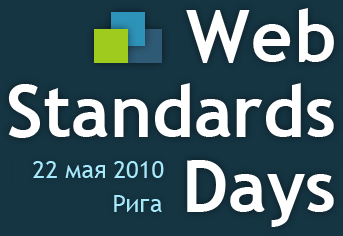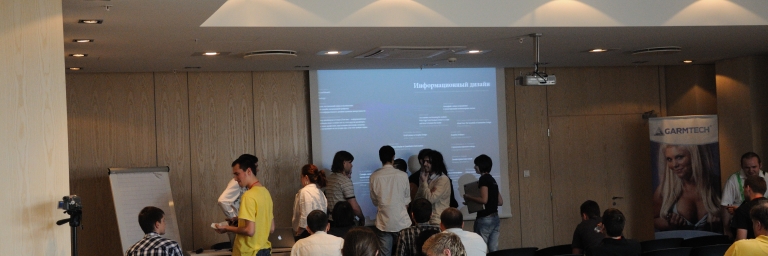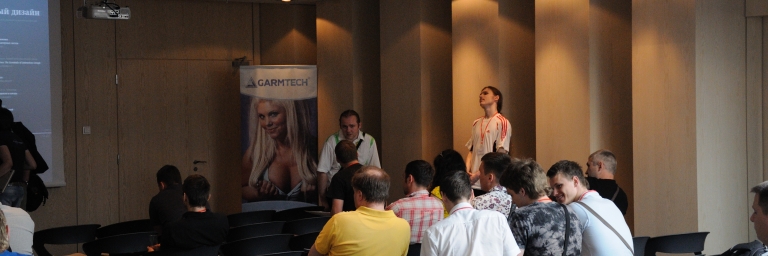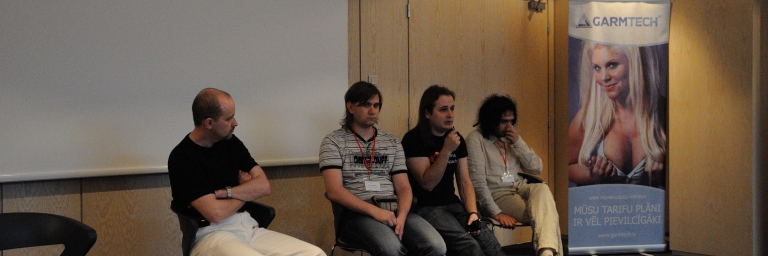Web Standards Days - Riga

Short review
I would like to start with the fact that everything was carried out at a level and quite smoothly. The topics were relevant, the information presented was relevant, and the speakers were interesting and even humorous. Technically, everything was also great - the conference room was not even a month old, so it is equipped with the latest fashion: two screens, one in front and one on the side, speakers evenly spaced throughout the room, wireless remote controls, microphones, and other goodies like WiFi and air conditioning . There were also no problems with drinking and snacks, hotel workers constantly replenished the table at the end of the audience with tea, coffee, lemonade and cookies.
The course of lectures was well worked out and there was enough time for everything, almost as if on schedule. Introduction, three reports of 30-45 minutes at the beginning of the day, with breaks of 15 minutes, a delicious lunch from your own wallet, after another three lectures, and at the very end the lecturers arranged a small holivarchik for a third of an hour.
Overview in more detail
As follows from the above daily routine, we were first told where we were, then we had exactly six lectures, and at the end a little light. Below I will put it all in time and other shelves.
11:00 - Nikita Seletsky
Opening
Nikita Seletsky, the head / teacher of the School of Web Technologies, greeted everyone with joy, spoke about the idea of the conference (although its name is quite enough for understanding), introduced himself and the others who needed to be presented, and wished everyone a pleasant day.

11:15 - Nikita Seletsky
Web layout in Latvia: Yesterday. Today! Tomorrow?
From the introduction, Seletsky smoothly proceeded to the presentation of his report. He told a little uncertainly, but this did not spoil the impression of the action. The content was statistical in nature. Charts were presented on the use of certain DOCTYPEs, on compliance with standards, on the presence of HTML5, and similar things. Statistics were collected from the websites of the conference participants, and when they presented data on the percentage of valid pages, there was a lowering of the eyes. This story was more introductory than informative. All the most interesting follows, without offense to Seletsky.
12:00 - Dmitry Dulepov
Features of creating websites for mobile devices
Dmitry Dulepov, a pioneer of web development in Latvia, spoke about the problems and solutions in the development of websites for gadgets. At first, the speaker encouraged everyone that they mostly use mobile Internet from smartphones on a tyk-based basis, so browsers that are worth bothering with come down to mobile versions of Opera, Safari and Chrome. They, in turn, are the most lively of living clients, and have almost the same capabilities as desktop counterparts. Therefore, the HTML part can be implemented without difficulty. Mobile browsers exclude flash and the like on the site, and also require a finger-oriented interface. And we come to the aid of a number of frameworks, detailed by the lecturer: iWebKit, WebApp.Net, SproutCore. He also started talking about Gianduia, but said nothing more than the name. It turned out very apple everything revolved around the iPad and iPhone. By the way, it seems that five of the six lecturers presented from the MacBooks.

13:15 - Anton Nemtsev
HTML5 and CSS3. The evolution of web standards
Anton Nemtsev, a civilian with more than ten years of experience, told everyone in detail about the goodies that await us in the web standards of the present-future. This was perhaps one of the most informative presentations. He gradually revealed as a great step forward is the HTML5, why it is more e involution than rethe will, what remained or disappeared from previous versions and what appeared new, what DOCTYPE became (and it became so -) and so on. And also in the second part, Nemtsev had a little dream about the web standards of the more distant future (for example, the idea of placing data on the page in plain CSS, or a simple declaration of the behavior of divs relative to each other, and so on), some of which are already in some places implemented (usually in Safari). The third part revealed the main CSS3 innovations and potential problems with them. Everything was accompanied by a demonstration of the work of existing components, like additional types of forms or animations. It turned out quite informative and new.
14:00 - All All All
Food. Finding a place to eat well
All All All, conference participants and not only, dispersed in Riga in search of a suitable restaurant or makdaka. I was lucky, I am local, I ate as I should. I can’t vouch for the rest, but it seems everyone came back happy.

15:00 - Vadim Makeev
CSS management Three years later
Vadim Makeev, a web evangelist at Opera Software, began the presentation by calling CSS development and management the most capacious part of any serious project, and talked about how to reduce the volume of this titanic work. The whole story was based on the experience of creating the yandex.ru style part, so there were no questions about the relevance of the proposed problems and about the correctness of the solutions. The first thing that Vadim brought to us was the modularity of .css files. It is very good when only everything you need is attached to the page - the load on the server and client is reduced. It is even better to create automatic CSS gluing into separate files at the development stage, so as not to lose latency when requesting each module individually. It was also said that you can’t put a browser definition and hacks on the server’s shoulders, it may turn out to be wrong, as well as about the very definition of these hacks and about their correct inclusion in the final file. There were a couple of words about the good style in CSS markup - the clown of a closing brace, the tree structure of elements (by parent), and the markup by comments of code departments. The usefulness of resetting some properties of standard HTML tags and the need to sort the contents of a CSS file according to certain criteria (the order of appearance on the page,author example ). It was presented very smoothly and clearly.

16:00 - Mikhail Baranov
Developer Tools - which tastes better?
Mikhail Baranov, the author of courses on web development at the Faculty of Retraining of Specialists of St. Petersburg State Pedagogical University, decided to talk about tools for raking HTML + CSS + JavaScript good. The first slide was marked by the number 1996, by which the author meant 2006 - the year of release of FireBug. With it came peace and quiet in the previously chaotic and terrible light of debug and parsing client applications. This report was full of fairly obvious things for any typesetter and JavaScript programmer, but he put the possibilities of these tools on the shelves and highlighted special moments in each of them. They mentioned ColorZilla, YSlow, IE Developer Toolbar, as well as native features in some browsers, like DragonFly from Opera, or noname from new IE and Chrome.

17:00 - Maxim Birch
Lean Startup. From an idea to a million
Maxim Bereza, a web developer from Latvia with his startup, came to the conference to share his experience in creating his own project. Maxim spoke well, but somehow too blurry. Nobody understood how much he earned and how much he invested, what exactly a startup is, except that it is a social network with some applications, and for how long they have been doing it. However, he introduced us to the technical part of the project - which frameworks were used (Django, jQuery), what is on the server, what principles they kept during creation (the main thing is ease of use as close to utopian as possible), where they keep the code (on the SVN server), saving traffic (compression of scripts and HTML), and also presented the startup’s Bible - “Getting Real”.

17:40 - Almost All Speakers
Round table “Web Standards vs. Rich Internet Applications »
Almost all the speakers, except for Mikhail Baranov, who joined later, slowly and calmly dug up the holivar’s ax. It was no longer about abstract Rich Internet Applications, but about Flash - the eminent representative of them. There were no obvious supporters of the flash, but there were those who shook the rest of the beliefs about this technology. A rather unobtrusive situation came out and everyone together discussed the pros and cons of the flash, to whom he annoyed and how, and what the poor would shine for him in the future (and, as it turned out, he still shines). A good ending, to be honest, a good laugh.

Instead of ending
The event is great. Maybe someone here will not find something new for themselves, but in any case this is a great occasion to have a good time among pleasant and interesting people. During lunch, I met two local students, learned a lot of interesting things, and even planned to cooperate with them on a certain project. So here. All the best!
PS All interesting links to presentation materials and photos from the conference are at the end of this topic.
